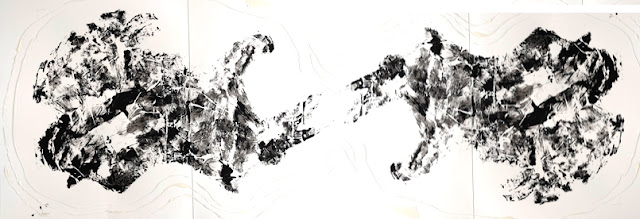What we call "Cultural Mediation" in Québec is perhaps akin to "Community Engagement" in the rest of the English speaking world. It's the "in" thing right now and while I admire its aims in general, I do not create art with this purpose in mind.
When the CACVS (Conseil des arts et de la Culture de Vaudreuil-Soulanges) and the MRVS (Musée Régional de Vaudreuil-Soulanges) organized their second Terre-Maires project, I thought I'd give it a go. The concept entailed creating artwork with a mayor of one of the many municipalities in this county. Politicians are not shrinking violets and have clearly defined ideas. This project required savvy listening skills and I planned on morphing into a sponge to fully understand my assigned mayor's vision to achieve a decent outcome that would please both of us.
The pandemic put a damper on the whole process which took much longer than it should have but I think it had a positive impact on our result over all. Had I created a work in combo with the mayor a year before, it would certainly have been completely different.
The project was multi-layered with many components. Politicians from multiple municipalities in the Vaudreuil-Soulanges county had to choose an object from the MRVS collection that had meaning for them. I was assigned Pierre Séguin, Mayor of Île-Perrot. He chose the following object:
This ex-libris belonged to Roger Maillet (who has a very interesting history in our region) and was designed by the artist Umberto Bruni. I undertook extensive research to find out all I could about these individuals and the ex-libris itself before I prepared for my first interview with the mayor. The ex-libris was to serve as a springboard for our collaboration.
The theme of the exhibition had to address climate change and sustainable development. I prepared a series of questions for my first meeting with the mayor in January 2020.
- Why did you choose this object?
- What do Roger Maillet and Umberto Bruni mean to you?
- What is your vision in regards to Île-Perrot? ...sustainable development? ...climate change challenges?
- How do you envision this artwork? What kind of contribution do you want to make to it? Are you okay with a digital component?
No one can accuse me of being unprepared! I went over to City Hall keen on brainstorming. I listened intently to what Mr. Séguin had to say and went away with a bunch of totally inappropriate ideas because of personal biases. So much for my active listening.
Here's what I heard:
- The ex-libris was chosen because of its historical significance in Île-Perrôt. Roger Maillet's home was known as the "ark" (l'arche). It became a cultural hub for artists where regular exchanges and creative activities took place.
- There are four municipalities on the island. The mayor would like to see them merge into one.
- A mayor's job is like that of a mother (wordplay...in French both mother (mère) and mayor (maire) sound the same). A mayor must ensure the security of its citizens, welcome new immigrants with open arms, find ways to save energy such as installing intelligent LED lighting on the territory, and much much more.
- Mr. Séguin loves taking pictures and would like to include them in the final artwork.
I was initially distracted by the chosen object, the ex-libris. I felt its elements had to be included in the final piece somehow. I fixated on the dove, the ark, water. I did quickie drawings of a dove, an earth mother, and a floating book with potentially the mayor's photos inside it. I reflected on peace, mother goddesses and arks. While I sensed I was not on the right track, I kept a record of everything nonetheless in case these ideas might be of use in future projects.
 |
| Dove |
 |
| Mother goddess holding an ark |
 |
| A book could include the mayor's photos while floating in the waters surrounding Île-Perrot |
We met again in February 2020. Mr. Séguin said he would soon send photos he had taken of the four municipalities. In March 2020 he emailed more historical info on Roger Maillet.
Pandemic lockdowns hit after our second meeting and all mayors in the county became overwhelmed with new priorities. The Terre-Maires 2 project was put on hold for an indefinite period.
Our venture was reactivated in 2021 and the mayor sent me these photos of the four municipalities in early February.
 |
| The shape of Île-Perrot - hear me roar! |
I switched over to Photoshop and started overlapping photos that Mr. Séguin had sent me onto a map of Île-Perrot. I did a number of them but was totally dissatisfied.
I flipped the image vertically and found it equally interesting. I decided to crop the original into an elongated format. I sent various options to the mayor along with matting possibilities and we agreed on a final solution. We presented both the initial and flipped elongated versions together. I love how the rose of the tilted map gently pierces through black, white and gray.
Once printed and framed, we were both satisfied with the end result from an aesthetic standpoint. Most importantly, the mayor felt it expressed the beauty of the region as well as his love and vision for the municipality.






Comments
Post a Comment